Where can you get reed valves for lower-cost, mass-produced, imported air compressors? Or for that matter, if the replacement reed valve, also known as a flapper valve, from the OEM is priced prohibitively, what do you do?
If it is not easy to find replacement reed valves or you don’t like the price, then your only choice is to make your own compressor reed valves.
This page provides a couple of examples as to how you can make your own compressor reed valve with the information provided primarily by readers like you, that have successfully made their own.
Table of Contents
- Air Compressor Reed Valve Location
- Broken Air Compressor Reed Valve Plate
- Air Compressor Reed Valve Plate Material
- Air Compressor Reed Valve Plate Fabricating
- Air Compressor Pump Gaskets
- FAQs (Frequently Asked Questions)
- Reader Comments & Responses
Air Compressor Reed Valve Location
The image below identifies the pump parts common to many air compressors including where the typical reed valve is located.
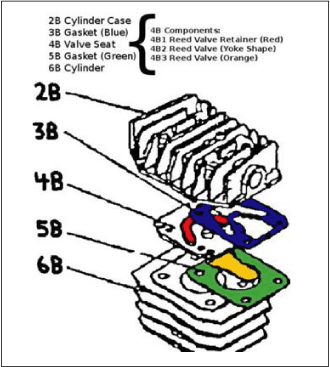
It is necessary to disassemble the compressor pump to find the valve plate or reed valve on a specific model of compressor.
Broken Air Compressor Reed Valve Plate
A broken or cracked compressor reed valve ensures that the compressor would not be able to build pressure satisfactorily. The compressor might just run and run and never build pressure past a certain pressure point, or the compressor might never build pressure at all depending on how damaged the pump reed valve was.
Like almost any new project, the first time you make your own flapper or reed valve will take much longer than if you were making your own all the time. Making your own valve will require a bit of work. It helps if you are handy with tools and enjoy DIY crafts.
When you tear down the pump you will likely find a thin sheet of metal with some type of fingers or flappers. It may look a bit like the following.
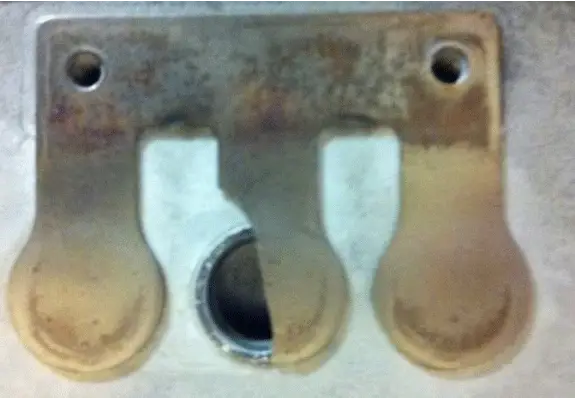
There are many shapes and sizes of reed valves and compressor valve plates, so don’t be concerned if one appears different than the one shown in the image. Recently I’ve been provided another example of a broken reed valve, this one from a Kaeser compressor.
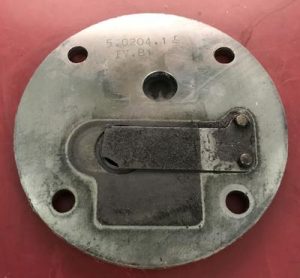
Do make sure that it’s the compressor reed valve that is broken, not the compressor valve plate itself. This is not an unusual occurrence due to the high heat inside the compressor pump, and the thousands and thousands if not millions of cycles the reed valves experience as they flap open and close as the cylinder cycles.
Air Compressor Reed Valve Plate Material
Some folks use a decent-quality paint scraper (one that has a large enough blade size) to cut the new valve plate from. The scraper blade is flexible, strong, and designed for long-term flexing. It is made out of metal, so, it has great heat-resistant properties.
Another approach is to purchase high-carbon spring steel shim stock. Get a supply that is as thick as the original valve plate. If you do a Google search using the phrase – high carbon steel shim stock – you will find a number of sources.
Regardless of your choice in reed valve raw material, just make sure that the material you select is one that remains flexible over thousands and thousands of cycles and is heat resistant. Otherwise, you’ll be tearing your compressor pump down again and building a new valve plate for it a lot sooner than desired.
Air Compressor Reed Valve Plate Fabricating
Using the old valve plate as a template, mark the new material with the correct shape. Use a scroll-type hacksaw to cut out the valve plate shape from the new stock.
To reduce vibration when cutting the thin spring steel, consider placing the shim stock on a thin sheet of wood first. This provides a base for the metal while you are cutting it, reducing vibration and noise as you cut the spring steel.
Drill comparably sized holes in the new valve plate corresponding to those in the original plate.
De-burr the new valve plate completely to ensure that it’s flat and no small spurs of metal prevent a tight fit over the ports in the valve pump.
Graeme provided the following: “I obtained some .015 shim stock, used marking blue, and scribed around my good remaining reed for the outline. I roughed out the shape with snips and finished it using fine files followed by fine wet and dry abrasive paper to round all the edges.
The old reed was used as a drill template for the holes. The only small concern I have is the shim stock is softer than the original reed material, but this actually may be advantageous. Only time will tell.”
Install the new reed valve plate into the compressor pump, as Graeme did display here:
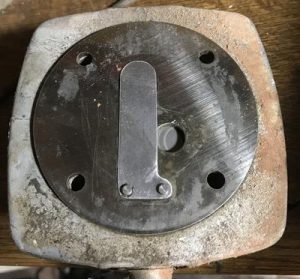
Another visitor commented on his Central Pneumatic compressor repair as follows:
“On a tear down the cause was clearly visible. One of the reed valves had gotten out of place and broke.
I had some stainless steel structure frame from an old microwave, I traced a form from the unbroken reed.
Cut it out with a Dremel.
The new piece was thicker and I spent 2 full hours (found an actual use for Maury and Jerry Springer!) thinning and straightening both sides on a sharpening stone.
Oddly there was no gasket in the compressor housing. I coated both planes with a layer of Greece and tightened all 4 bolts.
Reinstalled and plugged it in.
On the test, both gauges held air up to 60 PSI so I called it a victory and stopped (before the fix it didn’t hold more than 20 psi).”
Air Compressor Pump Gaskets
The question is, does your compressor need new compressor pump gaskets? Odds are pretty good that in the disassembly of the pump a gasket may have been damaged if your pump has them.
If you don’t use new gaskets when you reassemble the pump, it is quite likely that the compressor pump assembly will leak while in operation, and your air compressor will still not build pressure correctly.
Replace all compressor pump gaskets.
Since a valve plate was not easily available, forcing the custom manufacturer of the valve plate, likely the gaskets for that same pump may not be available either.
If a gasket kit for your compressor cannot be found, here’s how to make your own compressor gaskets.
Reassemble the pump with new gaskets and your custom-built reed valve plate, and your compressor and you are back in business.
FAQs (Frequently Asked Questions)
Air compressor reed valves are thin steel flaps fastened to the compressor valve plate. They’re a type of check valve that restricts the flow of air to a single direction. Reed valves are essential in allowing low-pressure air to enter the cylinders in all reciprocating compressors, and then pressurized air out of the cylinder.
As the piston travels down the cylinder of reciprocating air compressors, the suction valve opens to allow air in. As the piston travels upward and reduces the volume of the cylinder, the air is pressurized and the discharge valve is forced open to release the now pressurized air.
A sign that you may have a bad air compressor reed valve is that your compressor runs but doesn’t build pressure past a certain point. If the reed valve is broken or bad then the air goes back through the intake and no pressure is built.
How Do You Change a Reed Valve on an Air Compressor?
Time needed: 10 minutes
To change the reed valve on your reciprocating air compressor please follow these steps:
- Turn Off Compressor
Disconnect the air compressor and then remove the plastic cover around the motor and compressor
- Remove Cylinder Head
Unscrew the screws holding the head on top of the compressor cylinder and remove the head
- Check the Reed Valve
Underneath the head is the pressure plate, or valve plate, inspect the reeds for damage like warping or breaking.
- Make Note of Set up
Take note of how the pressure plate sets and the o-rings that seal around it
- Remove the Old and Install New Reed Valve Plate
Remove the reed valve plate and then install the replacement
Reader Comments & Responses
What Material Are Air Compressor Reed Valves?
Question
I have 2 questions about an old Ingersoll Rand compressor. Apparently, my compressor is obsolete and there are no parts available, so I need to make new reed flapper valves. My OEM valve is .010″ thick.
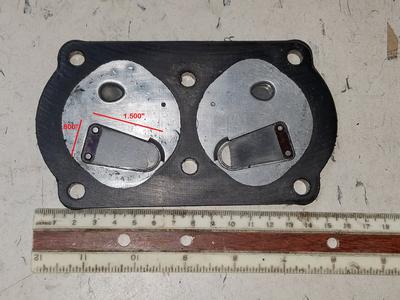
Question #1: What shim stock is better to use, 18-8 stainless or 1095 spring steel?
Question #2: Would .012″ or .015″ shim stock make the valve less likely to break again, or would the thicker material affect the fill timing/ability?
Thank you!
Response
Good questions.
The spring steel would be my choice, as it’s meant to flex.
I also would use a thickness as small as possible, that can withstand the pressure/area of the valve, also because thinner is more flexible and therefore less likely to break, as long as it isn’t hitting something other than the valve opening.
Too thick or stiff material will certainly impact efficiency, as a smaller opening due to limited valve travel will limit airflow.
Some pumps have a limiter finger above the valve, I take it this one does not?
Good luck.
If you have any questions regarding how to make our own air compressor reed valve, please leave a comment below with a photo if applicable so that someone can help you!
